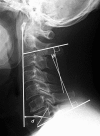Differences in Postoperative Changes of Cervical Sagittal Alignment and Balance After Laminoplasty Between Cervical Spondylotic Myelopathy and Cervical Ossification of the Posterior Longitudinal Ligament
- PMID: 31192093
- PMCID: PMC6542173
- DOI: 10.1177/2192568218784951
Differences in Postoperative Changes of Cervical Sagittal Alignment and Balance After Laminoplasty Between Cervical Spondylotic Myelopathy and Cervical Ossification of the Posterior Longitudinal Ligament
Abstract
Study design: Retrospective cohort study.
Objectives: To compare postoperative changes of cervical sagittal alignment (CSA) and cervical sagittal balance (CSB) after laminoplasty between cervical spondylotic myelopathy (CSM) and ossification of the posterior longitudinal ligament (OPLL) and to examine impacts of these radiologic changes on neurologic outcomes.
Methods: A total of 168 consecutive patients with CSM (CSM group) and 51 consecutive patients with OPLL (OPLL group) were included. As indicators of CSA and CSB, the C2-7 angle and C1-C7 sagittal vertical axis (SVA) were, respectively, measured before surgery and at 2-year follow-up. Neurologic status was assessed using the Japanese Orthopaedic Association score before surgery and at 2-year follow-up.
Results: Whereas both postoperative loss of C2-7 angle and increase of C1-C7 SVA were significantly greater in the elderly subgroup of the CSM group, patient age did not significantly affect these changes in the OPLL group. Preservation of C7 maintained C1-C7 SVA at postoperative 2 years only in the CSM group. Postoperative cervical kyphosis and sagittal imbalance significantly decreased neurologic improvement in the CSM group but not in the OPLL group.
Conclusions: Elderly patients with CSM have significantly greater postoperative loss of lordosis and increase in C1-C7 SVA than nonelderly patients, and both postoperative kyphotic deformity and sagittal imbalance significantly deteriorate neurologic recovery. On the other hand, although patients with OPLL, irrespective of patient age and preservation of C7, have significantly more loss of lordosis and increase in C1-C7 SVA than CSM patients, neither postoperative kyphotic deformity nor sagittal imbalance significantly deteriorates neurologic recovery in OPLL patients.
Keywords: cervical sagittal alignment; cervical sagittal balance; cervical spondylotic myelopathy; laminoplasty; ossification of the posterior longitudinal ligament.
Conflict of interest statement
Declaration of Conflicting Interests: The author(s) declared no potential conflicts of interest with respect to the research, authorship, and/or publication of this article.
Figures

References
-
- Kimura I, Shingu H, Nasu Y. Long-term follow-up of cervical spondylotic myelopathy treated by canal-expansive laminoplasty. J Bone Joint Surg Br. 1995;77:956–961. - PubMed
-
- Kawaguchi Y, Kanamori M, Ishihara H, Ohmori K, Nakamura H, Kimura T. Minimum 10-year followup after en bloc cervical laminoplasty. Clin Orthop Relat Res. 2003;411:129–139. - PubMed
-
- Sakai K, Yoshii T, Hirai T, et al. Cervical sagittal imbalance is a predictor of kyphotic deformity after laminoplasty in cervical spondylotic myelopathy patients without preoperative kyphotic alignment. Spine (Phila Pa 1976). 2016;41:299–305. - PubMed
-
- Tang JA, Scheer JK, Smith JS, et al. ; ISSG. The impact of standing regional cervical sagittal alignment on outcomes in posterior cervical fusion surgery. Neurosurgery. 2012;71:662–669. - PubMed
-
- Japanese Orthopedic Association scores for cervical myelopathy [in Japanese]. J Jpn Orthop Assoc. 1994;68:490–503.
LinkOut - more resources
Full Text Sources
Research Materials
Miscellaneous

